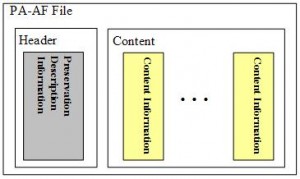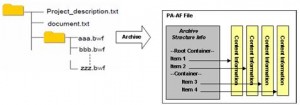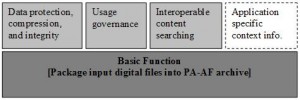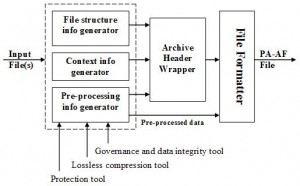MPEG-A Profesional Archival Application Format
MPEG-A Profesional Archival Application Format
Development webpage
This website presents the updates of the work of ISO/IEC 23000-6 (MPEG-A Part 6): Professional Archival Application Format.
What's new?
Reference Software
The implementation of MPEG PA-AF is delivered in form of reference software and the bitstream resulted by the software as conformance files.
Link to Reference software (updated 2010.07.30):
- The latest official release (RM003)
Introduction
Advances in digital multimedia technology have made the creation of multimedia content easier. With the availability of various hardware and software tools, creating multimedia content is no longer limited to professionals; anybody can do it. The Moving Picture Experts Group (MPEG) has foreseen a need for an interoperable multimedia content archival format for the preservation of multimedia contents and has been working on producing a standard to address this need. The standard for the interoperable multimedia content archival format is called ISO/IEC 23000-6 Professional Archival Application Format (PA-AF).
The PA-AF was developed during the course of ISO/IEC 23000. ISO/IEC 23000 (also known as “MPEG-A”) is an MPEG standard defined by selecting already tested and verified tools from the MPEG body of standards and combining them to form an AF. If a needed piece of technology is not provided within the MPEG, additional technologies originating from other organizations can be included by reference in order to facilitate the envisioned application format. For digital multimedia content archives, MPEG has designated ISO/IEC 23000 Part 6: PA-AF.
This website introduces the technologies used in the PA-AF and describes the advantages offered by the PA-AF and its relationship to other archival formats.
Scope of ISO/IEC 23000-6
The purpose of ISO/IEC 23000-6 PA-AF is to provide a standardized packaging format for digital files.
PA-AF specifies the following: a metadata format to describe the original structure of digital files archived in a PA-AF file; a metadata format to describe context information related to a PA-AF file and digital files archived in it; a metadata format to describe necessary information to reverse the pre-processing processes applied to digital files prior to archiving them in a PA-AF file; and a file format for carriage of the metadata formats and digital files.
While a general archival process may include processes ranging from creation, delivery to the archival system, to dissemination to consumers, PA-AF is limited in scope as follows. PA-AF specifies neither how to create input content nor any agreement on how the content should be handled and delivered to the archiving process. PA-AF assumes that input content for the archiving process is available in an appropriate digital format. PA-AF specifies the format of a digital archive produced by the archival process. It does not specify how the archive output by the archival process is disseminated to end-users.
Components of ISO/IEC 23000-6 (1 of 2)
Normative Components of a PA-AF File
A PA-AF file consists of a header and content part as illustrated in Fig. 1. The header part contains the metadata (called Preservation Description Information) needed to understand the PA-AF file itself and all files archived in it. The content part contains one or more archived files. These archived files are called Content Information. Content Information includes digital data in its original format as input into the PA-AF file and/or in the format obtained after pre-processing with tools allowed by this specification.

Fig. 1. Logical view of a PA-AF file
Preservation Description Information is in the XML metadata format. It includes Archive Structure Information, Context Information, and Pre-processing Information.

Fig. 2. Structure of input files stored in a PA-AF file
Archive Structure Information models relationships among the various kinds of Content Information. Archive Structure Information provides three functionalities:
– It preserves the structural relationships in Content Information. As illustrated in Fig. 2, digital files input into the PA-AF file can be hierarchical in one or more directories; however, in the physical PA-AF file format, they are stored in a flat manner. Archive Structure Information preserves the original hierarchical structure of the input digital files so that when Content Information is extracted from the PA-AF file, the structure of output digital files is the same as it was input into the PA-AF.
– It preserves file attributes of Content Information. The attribute values are stored in such a way to support cross platform Content Information extraction. In other words, even if Content Information of a PA-AF file is extracted to an operating system other than its original operating system, all file attribute values still prevail.
– It provides an entry point to access contents of the PA-AF file.
Context Information describes context information attached to a PA-AF file and Content Information. It includes PA-AF file creation information and content Information, such as information about what, how, when, where, who, and why; profile information of the Content Information, such as the file format, file size, audio and visual profile of the content (if it is an audio visual data); history of access to the Content Information, which records any actions applied to the Content Information, such as archiving and extraction. This record may include who the actor is and when the action was performed. In addition to pre-defined Context Information, the PA-AF allows inclusion of application-specific context information to satisfy application-specific requirements. Application-specific context information can be manifested in any format and archived in a PA-AF file as Content Information. PA-AF provides a link to this application-specific context information so that applications that can understand this information can read and use it; those that cannot understand it can simply skip it.
Pre-processing Information describes profiles of tools that can be used to reverse pre-processing applied to Content Information. It contains information, such as tool identification , parameters required to execute the tool, part of Content Information pre-processed with that tool, and tool location. Pre-processing processes that can be applied to Content Information include data compression, data protection, data integrity checking (authentication of originality), and data governance validation checking.
To implements the technologies described above, the following MPEG and non-MPEG technologies are used in the PA-AF:
– MPEG-21 Digital Item Declaration Language (DIDL) 2nd Edition Profile for PA-AF
– MPEG-21 Digital Item Identifier (DII)
– MPEG-21 Intellectual Property Management and Protection (IPMP) Components Base Profile for PA-AF
– MPEG-21 Rights Expression Language (REL) MAM Profile
– MPEG-7 Multimedia Description Scheme (MDS) Profile for PA-AF
– MPEG-21 File Format
– Lossless compression tool identifiers
– Encryption, hash, and digital signature identifiers
– Additional metadata dedicated for use in PA-AF only
The component technologies listed above can be used in combination to achieve the basic functionality and enhanced functionality of PA-AF as illustrated in Fig. 3. The enhanced functionality is optional and implemented on top of the basic functionality. For example, the combination of MPEG-21 File Format, MPEG-21 DIDIL 2nd Edition Profile for PA-AF, MPEG-21 DII, and MPEG-7 Creation Information Tool provides solutions to satisfy the basic functionality of PA-AF, which is packaging Content Information in a PA-AF file. By adding MPEG-21 IPMP Components Base Profile for PA-AF, one can add functionality, such as compression, protection, and integrity checking to the PA-AF. By adding MPEG-21 REL MAM Profile, one can add license information to govern the usage of the PA-AF file. Finally, by adding MPEG-7 MDS Scheme Profile for PA-AF, one can have interoperable description of Content Information that can be exploited to implement functionality for interoperable content searching. The combination of all component technologies provides a full solution for PA-AF.

Fig. 3. Basic and enhanced functionality of PA-AF
Components of ISO/IEC 23000-6 (2 of 2)
Architecture of PA-AF File Authoring Tool

Fig. 4. Overview of a PA-AF packaging tool for creating a PA-AF file
Figure 4 outlines an informative packaging tool that may produce an output file that complies with the PA-AF specification. The tool consists of the following modules:
– A file structure information generator, which analyzes and generates metadata to model hierarchical structure of the input files.
– A context information generator, which creates metadata to record context information related to the output PA-AF file and input files to be archived.
– A pre-processing information generator, which creates metadata for required tools and their execution parameters to reverse any pre-processing processes applied to the input files.
– An archive header wrapper, which combines all the generated metadata into PA-AF file header.
– A file formatter, which takes the header and input files (original or after pre-processed) and wraps them in a file.
Advantages of Using ISO/IEC 23000-6
Advantages offered by the PA-AF compared to other conventional data archival software such as tar, zip, etc are as follows.
- The PA-AF provides comprehensive metadata to model context information of files archived in a PA-AF file. Context information plays an important role in understanding what data is being archived in a PA-AF file. Without good context information attached, archived data may have less value or in extreme cases become useless.
- The PA-AF provides a flexible mechanism to accommodate context information specific to an application domain. Context information other than one that defined by the PA-AF specification can be included in a PA-AF file. An example of such application-specific context information is METZ metadata.
- The PA-AF provides a flexible mechanism to process input files prior to archiving them in a PA-AF file. The PA-AF does not specify any mandatory pre-processing tools or modules [data compression, data protection, data integrity checking (authentication of originality), and data governance validation checking] prior to archiving Content Information but does specify a mechanism to describe the use of such pre-processing tools or modules. In this way, a PA-AF file creator can choose specific pre-processing tools that suit his preference.
- The PA-AF supports cross-platform file extraction. Because the PA-AF preserves the structure and value of original file attributes in a platform-independent way, files archived in a PA-AF file can be extracted to any other target platform besides its original platform. For example, files archived under Microsoft TM FAT32 file system can be extracted to UNIX’s file system seamlessly.
- The PA-AF file design supports separation of metadata and files being archived. A PA-AF file can contain only metadata, while files being archived can be stored in one or more archived files. This feature can be applicable for a very large archival system where there are many large files to be archived. The advantage of this design is that it provides a feature to browse a set of archived collections by accessing only one file (the file that has the metadata) and provides a link to the desired archive file.
Relationship of ISO/IEC 23000-6 and Other Archival Standards
One important existing standard for archival systems is the one specified by the Reference Model of the Open Archival Information System (OAIS) [2]. The OAIS Reference Model is a framework for understanding and applying concepts necessary for long-term digital information preservation (where “long-term” is long enough to be concerned about changing technologies). The OAIS Reference Model is aimed at a complete archival system, including an abstract model of data flow, a format for inputting data to the OAIS Reference Model’s archival system, and a format for disseminating data from the archival system to consumers. In contrast, the scope of the PA-AF is limited to providing a standardized packaging format for archiving digital files. The packaging format standardized by the PA-AF can serve as an implementation of the information package specified by the OAIS Reference Model.
© 2010 MPEG-A Profesional Archival Application Format
| This content is originally provided by Houari MCCB Lab., KAIST
